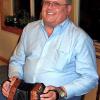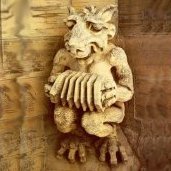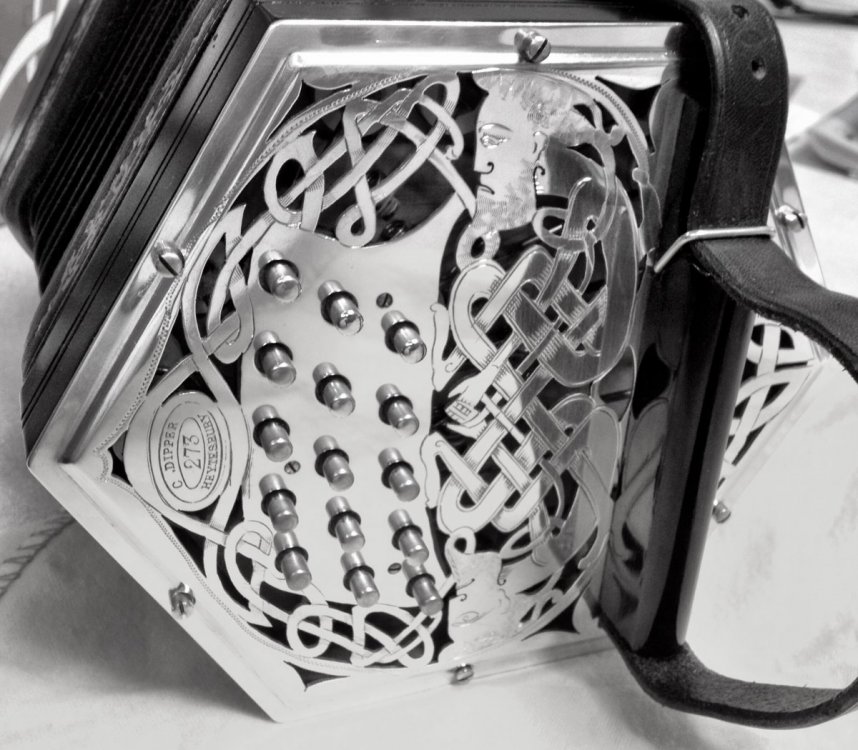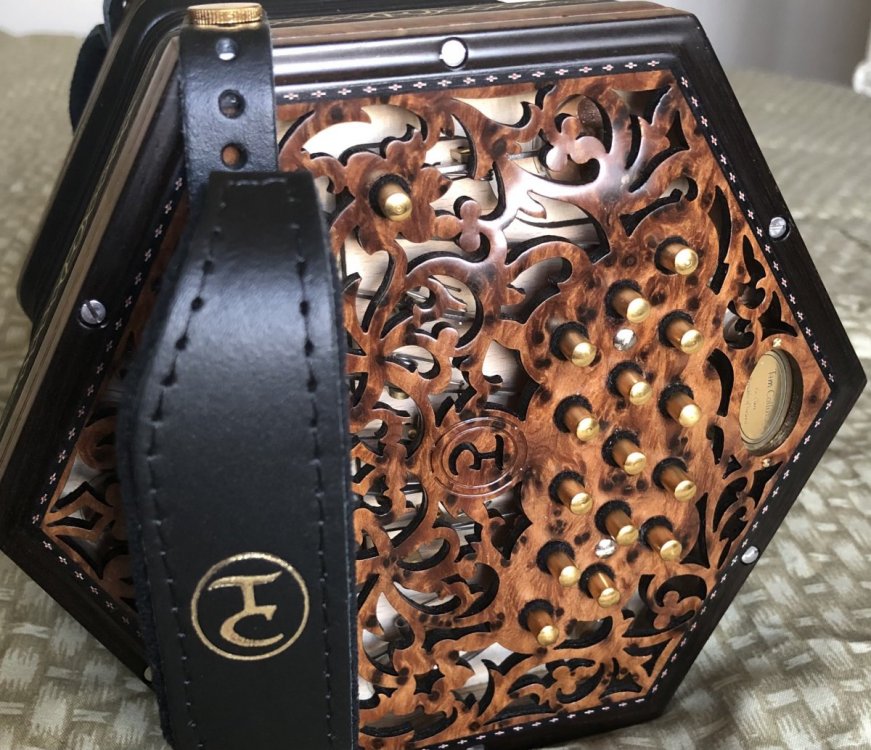-
Posts
595 -
Joined
-
Last visited
Profile Information
-
Gender
Male
-
Location
Seattle Area
Recent Profile Visitors
3,500 profile views
Bruce McCaskey's Achievements

Heavyweight Boxer (5/6)
-

Padraig Rynne's Concertina
Bruce McCaskey replied to Ed Ebel's topic in General Concertina Discussion
I believe he used to own a 38-button Carroll in C/G but that was more than a decade ago. Carroll only made four or five of them and I owned one for a time. Somewhere I have a photo of Padraig with it but it wouldn’t be easy to find it. i’ve no idea if he still has it. -

Thoughts On An A/e Tina
Bruce McCaskey replied to Brazen Kaine's topic in General Concertina Discussion
Just ran across this thread. I don’t know that I have much to add to this but thought I’d mention that I have an Edgley in A/E tuning. Bought it new from Frank about 20 years ago and still love it. I was introduced to that tuning when Tom Lawrence bought one from Frank to play with pipers and he let me try his out. I wasn’t looking to do the same but I loved the pitch so bought one for myself. i have a Dipper and a Carroll in C/G tuning but although I don’t play it often, I get out the A/E now and then just to enjoy the pitch. Additional comment: Just realized the original post is over 20 years old. Wouldn’t have resurrected this thread had I realized that but since I’ve left a comment now I won’t delete it. -

New Anglo Concertina beginners instruction book
Bruce McCaskey replied to richard's topic in General Concertina Discussion
I see some comments regarding whether the book should provide more information about the various methods of playing Anglo concertina and perhaps establish that it teaches a regional style. While not addressed in the title, the introduction mentions that there are other styles of playing Anglo, describes three of them and establishes that the book teaches a single style popularly referred to as cross-row. It even acknowledges that there are variations in that method. I’d originally included some additional text that described it as being the approach popular in Ireland but the Hal Leonard editor I was working with didn’t feel that was needed. As to formally attributing specific influences, I’ve attended workshops and classes with several different people over the years. Certainly I’ve had some strong influences but I feel it would be inappropriate for me to say I’m offering instruction in the style and technique of a particular source. Not that I wish to deny or cloud a particular person’s influence in my learning and impact on my style, but rather I don’t think it’s appropriate for me to put out a book that claims to be teaching someone else’s approach unless I have an endorsement for that. I’d also fear that a book suggesting it is based even in part on someone else’s teachings or style would promote sales based on the reference and not actual content. In addition, without the oversight inherent to endorsement the book may provide an inaccurate representation . On the other hand, it was never my intent to overlook acknowledgement. The following is an excerpt from the book’s dedication. “Shortly after purchasing my first Anglo, I had an opportunity to attend a workshop with Ireland's premier Anglo concertinist, Noel Hill. I was astounded by his versatility and mastery of the instrument. I've had the privilege of establishing an enduring friendship with Noel, who continues to inspire me.” Closing, I’m not suggesting anyone’s comment was wrong, misguided or overly critical, only adding my perspective and thoughts. -

New Anglo Concertina beginners instruction book
Bruce McCaskey replied to richard's topic in General Concertina Discussion
I discussed this topic with Noel Hill before writing my Hal Leonard book and reviewed it with him again a few days ago. Quoting Noel: “I simply don’t want my class materials (including class recordings) shared outside of my class as these materials form a large part of my livelihood. My style, approach, fingering, recordings and music generally are there for all to study if one has an interest.” -
Depends on the model. Frank Edgley and Wally Carroll used to respond to requests for custom sized hand rests/palm bars as did Bob Tedrow. I have purchased replacements in custom sizes from makers too. I imagine you could get them from other makers that are sill in business as well as replacement straps if needed. Not so likely for Rochelles and other Chinese and Italian models I’d guess but there are work-arounds such as adding to the existing bars. People have reported success in effectively raising them by putting an appropriate length of pipe insulation on them. Essentially they open the slotted side enough to slide it over the top of the existing bar. I suggest you start by connecting the maker. If no possibilities there then check with repairers.
-

New Anglo Concertina beginners instruction book
Bruce McCaskey replied to richard's topic in General Concertina Discussion
I didn’t mention the book here because I was reluctant to self-promote. Nothing wrong with doing it but I decided I’d see how the book was received on its own. You put a bit of yourself into a project like this and can’t be certain if the result will be accepted, faulted or dismissed. Since it’s been mentioned here now and there are a few questions I’ll provide some background and insights. A few years back I was contacted by the Hal Leonard music publishing company. They’d had a recommendation and asked if I would write an Anglo Concertina beginners book for them to become one of their “Method” series. Hal Leonard is the largest music publishing company in the world so I felt honored. I invested considerable time into creating this product and for button charts I utilized a format I’d been employing for private lessons. It’s worked for me and my students, time will tell how a larger audience will react. I targeted an absolute new beginner that knows nothing of Anglos, doesn’t have access to other Anglo players and doesn’t know how to read music. I included instruction for both 20 and 30 button instruments and both Wheatstone and Jeffries button layouts. The only restriction really is that the book assumes the student has a C/G instrument. I tried to put everything into this book that I would have liked to have had access to when I first started out in 2003. I hope others can relate to it and find something useful within. Expanding on button chart orientation, I think every Anglo button chart I’ve even seen had the button rows laid out horizontally. Certainly that approach makes sense; if you are holding the instrument and rotate it left or right to look at the buttons then they are in a horizontal configuration like the charts. That said, horizontal button charts never worked well for me because when I’m playing I think about the buttons in a vertical perspective (up and down), essentially the same alignment up and down as my fingers. Buttons on the C row for example are above or below each other, not left or right of each other as they appear on a horizontal button chart. Also, yes, within the book the fingers of each hand are numbered 1 to 4 with 1 being the index finger and the numbers are preceded by an “L” or an “R” to indicate the associated hand. No 5’s for fingers because aside from operating a drone (a rare feature) and the air button, the thumbs are never used. As I teach I try to guide students into building a mental map of just the buttons they use for each exercise and a default notion of which buttons/notes are associated with each finger. As they progress through the exercises, the map incorporates more buttons. I’ve also incorporated instruction on basic elements of reading music, introducing new concepts as the exercises progress. The octave notation of ABC note naming is used to identify the notes and the recommended finger for each note and insights into fingering choices and adjustments are included. To be clear, I’m not saying an Anglo player has to be able to read music, but I think it’s pretty useful for instructing someone that’s learning on their own from a book. Hal Leonard has a very nice audio player interface on their website that offers access to audio recordings of exercise tunes via an included coded number. The player’s built-in features allow students to choose tunes from the book and slow them down, change pitch and designate A/B points for looping selected segments. No need for the student to have special software, it’s already there and included with the purchase. I should also note there is an errata page included within the sound recordings that can be viewed and printed. Some of my last comments to the publisher’s editor didn’t get incorporated before printing. The non-paper formats have this corrected already. This book is based on my perspective and my approach to the instrument shaped by what I’ve learned over the years. There are other ways of approaching it, presenting concepts and making fingering choices and I don’t suggest any of them are wrong. The fingering I’ve used should be familiar to cross-row players although it seems everyone has favorite variants. I receive a small percentage of book sales but honestly I had no monetary motivation in writing this, I just wanted to share some of what I have learned with absolute beginners to help them get started. Initial reviews and personal feedback have been very encouraging to date and if people find useful things within the book and share them with others I’ll be happy. The title is “The Hal Leanord Anglo Concertina Method.” It’s available in print from many sources, in Kindle format on Amazon and on Hal Leonard’s website in their own paperless format. -

Looking for good quality D/G Anglo - CLOSED
Bruce McCaskey replied to Capt Thighbiter's topic in Buy & Sell
I don’t know where you are but I have a G/D Edgley in excellent condition that’s located in the Seattle area. PM me if interested. -

Marcus Traveller review.
Bruce McCaskey replied to Mikefule's topic in General Concertina Discussion
Thanks for the video links! -

Marcus Traveller review.
Bruce McCaskey replied to Mikefule's topic in General Concertina Discussion
Thanks for the review. I’ve long been intrigued by this model but have never encountered one. I’ve seen the video on the Marcus website but would love to see more videos if you’d be inclined to post. I suspect that if I ever actually got my hands on one to try I’d be inclined to order my own -
No inquiries so I’ve decided to withdraw it from sale offering with a contribution to Paul for the use of the listing space.
-
This is about three years old. I bought it new in the fall of 2019 but didn’t find many opportunities to play it so it is little used and in excellent condition. Includes the case. The price is $2,350 and I’ll pay the shipping.
-
-
I sent a PM yesterday, did you see it?
-
John, it’s difficult to do a direct comparison to my Dipper. The Dipper was sold as a “Professional County Clare” and Colin said he put his “best” reeds in those. It’s metal ended with a bright and distinctive sound. It’s maybe 30 years old and I’ve played it a lot, though not so much in the last couple of years, and the reeds are well broke in. I’ve included a photo of the Dipper below. The TC Suttner is new (literally just made a few weeks ago) and wooden ended. The reeds haven’t been played much yet and they are a little softer toned and don’t have the brightness of the Dipper. Still it’s a good sound and I expect they’ll sound much richer in a few months of playing. The seven fold bellows move very readily and the buttons only require a light touch to operate. I find the action to be crisp and responsive. The Dipper...
-
Last summer I had a chance to meet Tim Collins in Seattle and he graciously permitted me to try out two of his personal instruments. I was quite impressed and a few days later looked into ordering one for myself. I hadn’t been following the concertina market too closely and until I met with Tim I had been unaware that Jürgen Suttner offered a Tim Collins (TC) model at the top of his Anglo line. I placed an order and a little over a year later, the completed instrument was delivered to my door. Lovely instrument, 31 gold plated buttons (D drone), gold tooling and Thuya burl ends.











